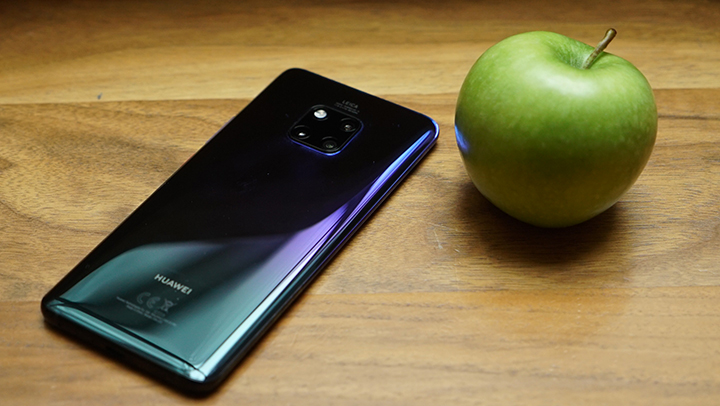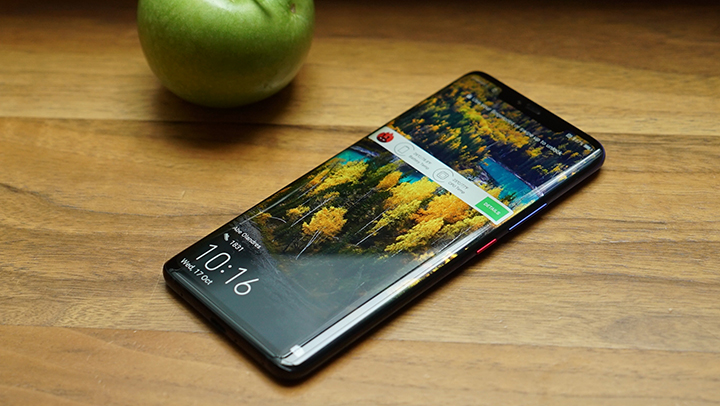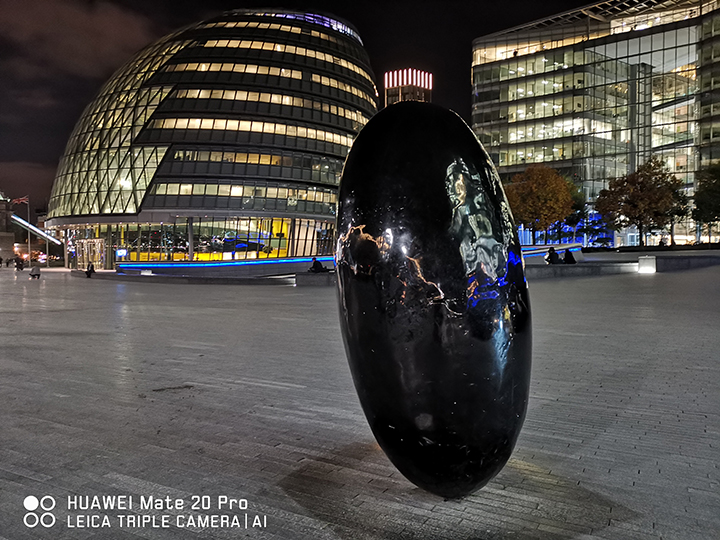The Huawei Mate 20 Series was just launched here in London yesterday. There were four models — the Mate 20, Mate 20 Pro, Mate 20 RS and Mate 20 X. Of the lot, the Mate 20 Pro drew the most attention so here’s our initial hands-on impressions of the device.
The Mate 20 Pro is the hero device of the lot and is packed with almost all imaginable features one can think of for a flagship smartphone.

Huawei went back to the drawing board and re-imagined the design of the Mate 20 Pro. There’s not much semblance from the old Mate series but more like an improvement of the existing P20 Pro, which is good.
The body is completely covered with glass from the front all the way to the back with curved sides up front and tapered sides at the back for a better and more comfortable grip. Huawei has not indicated if it’s using Gorilla Glass this time but maybe it’s the same one used with the P20 Pro.

The front panel is a large 6.39″ OLED display with 2K+ resolution or 1440 x 3120 pixels, giving a crisp 538ppi pixel density. The aspect ratio is an unusual 18.7:9 with a screen-to-body ratio of 87.8%, not the highest but still pretty impressive.
The curved sides give it better coverage, allowing for a narrower bezel. The OLED display is very bright with a maximum brightness of 850 nits and is very crisp with vivid colors. There’s quite a large profile for the notch due to a lot of sensors included in the front camera, including an IR sensor and facial recognition.

For the very first time, Huawei is employing an under-display fingerprint sensor on the Mate 20 Pro. This is a similar execution as the ones earlier found in several Vivo smartphones (VIVO X21UD, VIVO NEX, etc.). This gives the front panel more real estate screen for the display. The scanner is a small area around the lower middle corner and registers up to 5 unique fingerprints. It’s fast and accurate but not as fast as one would expect on a typical physical fingerprint sensor. There’s about a fraction of a second delay when scanning. Nevertheless, we think it’s a step in the right direction.
As for the rear camera, there is a cluster of 3 cameras in the gathered around the center in a squarish placement with the 4th element being the dual-tone flash, made obviously for symmetry.

The Monochrome sensor is no longer included, a feature that has been introduced since the P9 with Leica co-branding. The new 3-camera system is a telephoto, wide angle and ultra wide angle field-of-view. Perhaps, this will be the differentiation between the triple cameras of the P20 Pro and the Mate 20 Pro or this new system will become the default setup moving forward. The macro capability is also very good and can come as close as 2.5cm minimum focusing distance.
Based on interviews with executives from Huawei, the 40MP sensor is very good enough that there is no need for a dedicated monochrome sensor to get additional image data in order to produce the best possible photo. The very large sensor size (1/1.7″) is more than enough to do the job.
Here are some sample shots we got going around London:
The Night Mode feature allows you to shoot long-exposure shots at night at handheld.


Of the 3 rear cameras, only the telephoto camera comes with optical image stabilization (OIS) while the other wide angle cameras use the AI Image Stabilization (AIS). The front camera has a 24MP, f/2.0 sensor with 3D Depth Sensing.
Powering the Mate 20 Pro is the new 7nm Kirin 980 chipset. The processors are composed of 2 x Cortex A76 running at 2.6GHz, another 2 x Cortex A76 at 1.92GHz and a quad-core Cortex A55 1.8GHz for power efficiency. This is paired with the first Mali-G76 MP10 GPU for better gaming performance.
The benchmark scores will bear witness on the improvement of this chipset over the Kirin 970.
Benchmark Scores:
Antutu Benchmark: 273,233
PCMark: 10,169 (Work 1.0), 7,645 (Work 2.0)
3DMark: 3,507 (Sling Shot Extreme, Open GL 3.1), 4,203 (Sling Shot Extreme, Vulcan)
GeekBench 4: 3,295 (Single Core), 9,831 (Multi-Core)
AndroBench: 824MB/s (Read), 194MB/s (Write)
One of the more unique selling points of the Mate series is the large capacity battery. The Mate 20 Pro sports a huge 4,200mAh internal battery, slightly bigger than the predecessor. We’re still running our standard tests to get the ratings for the battery life but will include that in our final review.

What’s more interesting is that the Mate 20 Pro is capable of doing ultra fast charging with a 10V4A (40W) SuperCharge wall charger that’s capable of getting to 70% charge in just 30 minutes. Likewise, there’s a fast wireless charging (15W). A first in the world is that the Mate 20 Pro can actually do reverse wireless charging so you can charge your iPhone XS or Note9 by simply placing them together with the Mate 20 Pro.
Other notable features include IP68 dust and water resistance for up to 1.5 meters and 30 minutes, a hybrid dual nano-SIM with nano card up to 256GB, 4G LTE Cat. 21, Bluetooth 5.0 and dual speakers for better sound quality.
The Huawei Mate 20 Pro is priced at EUR1,049PHP 64,625USD 1,101INR 93,349CNY 8,022 (roughly Php65,500USD 1,116INR 94,621EUR 1,063CNY 8,129) although Philippine pricing will certainly be much lower than this (based on our experience with the P20 Pro). Available colors in Emerald Green, Midnight Blue, Classical Black, Twilight, and Pink Gold.
Our full review will come out next week. For the meantime, you can also watch our hands-on video below:
| Huawei Mate 20 Pro | |
|---|---|
| Display | 6.39" 19.5:9 OLED, 2K+ (1440 x 3120), 538ppi, 87.6% screen-to-body ratio |
| CPU | Kirin 980 2.6GHz octa-core processor (2xA76 @2.6GHz + 2xA76 @1.92GHz +4xA55 @1.8GHz) |
| GPU | Mali-G76 MP10 |
| RAM | 6GB/8GB RAM |
| Storage | 128GB/256GB storage expandable via Nano memory card (memory card or nano sim) |
| Rear camera | 40MP (Wide-Angle Lens) f/1.8 + 20MP (Ultra Wide-Angle Lens) f/2.2 + 8MP f/2.4 (3X Telephoto Lens) |
| Front camera | 24MP 3D RGB + IR front cameras (Leica |
| Camera Features | - Underwater shooting mode - AI portrait color mode |
| SIM | Dual SIM |
| LTE | 4G LTE Cat. 21 |
| Wi-Fi | Wi-Fi 802.11 a/b/g/n/ac |
| Bluetooth | Bluetooth 5.0 |
| GPS | Dual GPS |
| Biometrics | - In-screen fingerprint scanner - 3D Face Unlock |
| NFC | Yes |
| IR Blasters | Yes |
| 3.5mm audio port | n/a |
| Features | - IP68 resistance - Invisible Dual speakers - App Twin |
| USB | USB Type-C |
| Battery | - 4,200mAh battery with SuperCharge - Wireless Charging Support - Wireless Reverse Charging |
| OS | EMUI 9.0 (Android 9.0 Pie) |
| Color | Emerald Green, Midnight Blue, Classical Black, Twilight, Pink Gold |
Check this out –> Huawei Mate 20 Pro vs. Samsung Galaxy Note 9 Comparison Review

YugaTech.com is the largest and longest-running technology site in the Philippines. Originally established in October 2002, the site was transformed into a full-fledged technology platform in 2005.
How to transfer, withdraw money from PayPal to GCash
Prices of Starlink satellite in the Philippines
Install Google GBox to Huawei smartphones
Pag-IBIG MP2 online application
How to check PhilHealth contributions online
How to find your SIM card serial number
Globe, PLDT, Converge, Sky: Unli fiber internet plans compared
10 biggest games in the Google Play Store
LTO periodic medical exam for 10-year licenses
Netflix codes to unlock hidden TV shows, movies
Apple, Asus, Cherry Mobile, Huawei, LG, Nokia, Oppo, Samsung, Sony, Vivo, Xiaomi, Lenovo, Infinix Mobile, Pocophone, Honor, iPhone, OnePlus, Tecno, Realme, HTC, Gionee, Kata, IQ00, Redmi, Razer, CloudFone, Motorola, Panasonic, TCL, Wiko
Best Android smartphones between PHP 20,000 - 25,000
Smartphones under PHP 10,000 in the Philippines
Smartphones under PHP 12K Philippines
Best smartphones for kids under PHP 7,000
Smartphones under PHP 15,000 in the Philippines
Best Android smartphones between PHP 15,000 - 20,000
Smartphones under PHP 20,000 in the Philippines
Most affordable 5G phones in the Philippines under PHP 20K
5G smartphones in the Philippines under PHP 16K
Smartphone pricelist Philippines 2024
Smartphone pricelist Philippines 2023
Smartphone pricelist Philippines 2022
Smartphone pricelist Philippines 2021
Smartphone pricelist Philippines 2020